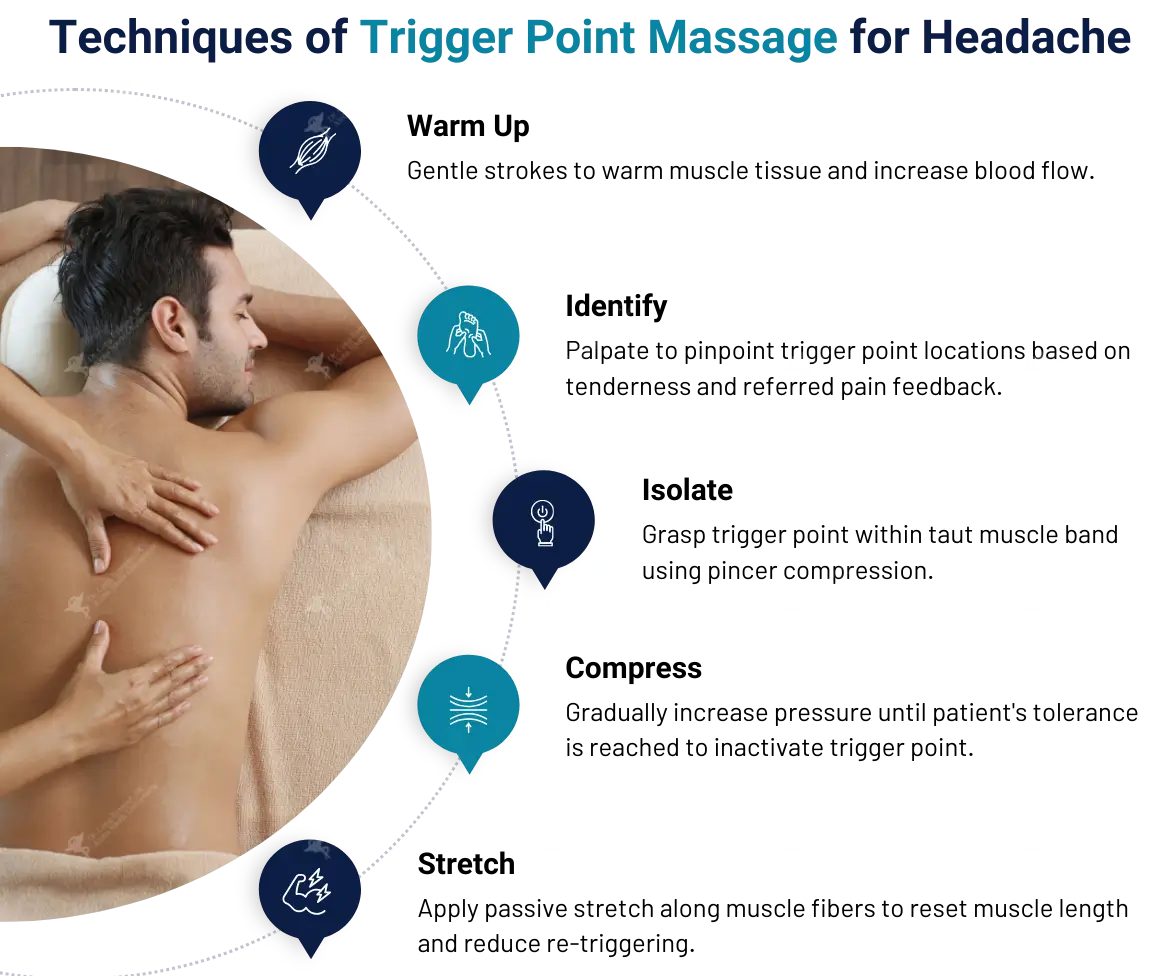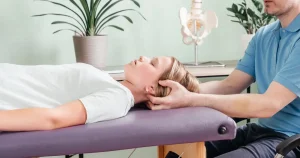
Tension headaches are an extremely prevalent disorder that causes disability for millions globally. Their dominant triggers and higher incidence in women suggest hormonal and stress-related influences.
As a trigger point massage therapist with over a decade of experience, I have seen countless patients suffering from frequent and severe tension headaches. In my practice, I have found that trigger point massage can be an extremely effective treatment for reducing headache pain and frequency.
In this blog post, I will explain what trigger points are, how they contribute to tension headaches, and why massage effectively manages them.
What are Trigger Points?
Trigger points are hyperirritable areas found in taut bands of muscle fibers. When trigger points are active or ” triggered,” they can cause pain. This pain often radiates in predictable patterns from the trigger point location. For example, a trigger point in the upper shoulder can cause discomfort around the base of the skull.
Trigger points develop for many reasons, including poor posture, musculoskeletal injury, nutritional deficiencies, physical or emotional stress, and more.
Trigger points can last for weeks or even years if not addressed. Fortunately, trigger point massage is a practical treatment approach.
Characteristics of Trigger Points
- Exquisite tenderness upon compression
- Referred sensory symptoms like pain or tingling
- Referred motor symptoms like reduced range of motion

How Trigger Points Cause Tension Headaches
Trigger points cause headaches in two main ways:
- They cause referred pain that radiates up into the head. For example, trigger points in the sternocleidomastoid muscles of the neck often produce pain felt in the temples and forehead.
- They perpetuate a cycle of protective muscle contraction. By reducing pain, the body instinctively contracts muscles around trigger points. This muscle tension can compress nerves, reduce blood flow, and cause headache pain.
When multiple Trigger Point Massage are active, the referred pain and muscle tension feed into one another. It causes even more trigger points to form, and the headache pain intensifies. Breaking this cycle is crucial in relieving tension headaches long-term.
The Importance of Trigger Point Massage
Many traditional headache treatments, like pain medications, only mask symptoms temporarily. They don’t address the underlying source of tension headaches: activated trigger sites.
Trigger point massage therapy applies direct and sustained pressure to inactivate trigger points manually. It reduces referred pain and relaxes contracted muscle fibers. Studies show that subjects receiving trigger point massage experience immediate and long-term headache relief.
As a drug-free, non-invasive treatment option, trigger point massage also avoids the side effects and risks associated with medication use. For chronic headache sufferers, trigger point massage enhances the quality of life without reliance on pills.
Related, Is Trigger Point Therapy Effective?
Methods for Diagnosis
- Patient pain recognition – Having the patient identify areas of pain upon palpation. Referred pain patterns help distinguish trigger points.
- Visual examination – Looking for surface tension and twitch response when the suspected trigger point area is pressed.
- EMG studies – Measuring electrical activity in trigger point areas compared to surrounding tissues.
Treating Trigger Points
- Manual therapy – Applying direct pressure to trigger points or stretching the affected muscles. It includes massage techniques, dry needling, and a range of motion exercises.
- Injections – Injecting anesthetics, corticosteroids, or other drugs directly into trigger points. It chemically deactivates trigger sites.
Technique for Trigger Point Massage
- Warm Up – I apply gentle strokes to warm the muscle tissue and increase blood flow. Warm tissues are more receptive to treatment.
- Identify – Next; I palpate the area to pinpoint exact trigger point locations based on tenderness and referred pain feedback.
- Isolate – I grasp the trigger point within the taut muscle band using pincer compression. It isolates it away from surrounding tissues.
- Compress – Maintaining pincer compression, I gradually increase the pressure until the patient’s tolerance is reached. It directly inactivates the trigger point.
- Stretch – Finally, I apply a passive stretch along the direction of the muscle fibers. It helps reset muscle length and reduce re-triggering.

Do You Want to Break the Cycle of Tension Headaches?
Contact me today to ask about incorporating trigger point therapy into your treatment plan.
Get AppointmentThe Final Words
Trigger point massage is a highly effective way to find relief from recurring tension headaches. Massage techniques directly inactivate the knotted muscle fibers, causing referred pain and headache symptoms.
By targeting root causes rather than just masking pain temporarily, trigger point massage for headache provides longer-lasting relief. It also avoids the adverse effects and costs of medication treatments.
While more research is still needed, current studies overwhelmingly demonstrate the benefits of trigger point massage for headaches.
As a trigger point massage therapist, having successfully treated many patients, I am a strong proponent of therapeutic massage to relieve tension headaches.
I encourage anyone struggling with frequent headaches to explore trigger point massage. When performed skillfully and consistently, it can help break the cycle of pain naturally and improve quality of life dramatically.

Meet Dr. Craig Eymann, a dedicated chiropractor and yoga enthusiast with over two decades of expertise in spinal health, sports chiropractic, and personalized care, prioritizing misalignment correction for swift injury resolution.
Categories
Tags
Recent Blogs
Are you suffering from Headaches, too?
Book an appointment with our Chiropractor and get pain relief first-hand.
Get Appointment



Leave A Comment